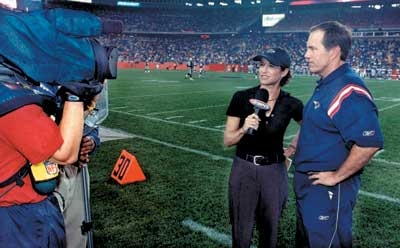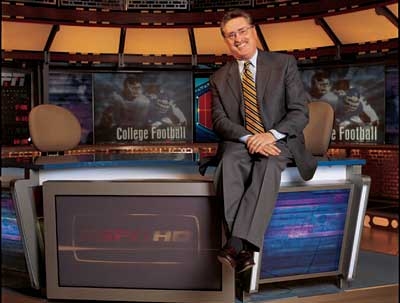ESPN High-Def Touchdown Page 2
ESPN's transition to HDTV hasn't been without its share of technical hiccups. Remote operations producer Steve Carter details some minor problems involving system timing, while Burns notes the challenges posed by new high-def gear. "Some of the time, we're using the very first model of a piece of equipment - you know, a camera with serial number 00001," Burns explains. "For a company that's used to being great, the newness can sometimes be frustrating."  Even sideline correspondent Suzy Kolder's handheld segments are shot in high-def.
Even sideline correspondent Suzy Kolder's handheld segments are shot in high-def.
As one of the people responsible for holding everything together during a broadcast, Rothman now has to account simultaneously for the high-def widescreen and traditional 4:3 aspect ratios. "What we have to remember is that the 4:3 cut is going out to 90-something percent of our viewers," he says. To help the process, 16:9 monitors in the production truck have been "masked" on both sides to approximate the 4:3 dimensions, while many of the camera operators shooting in widescreen have used grease pencils to roughly outline the 4:3 frame on their viewfinders.
Rothman adds that most of the HDTV-related glitches to date have stemmed from minor compatibility issues. "It's one thing to convert a camera and a tape machine," he explains. "But things like the virtual technology we use to create the first-and-ten line have proven a little tougher. Truthfully, we're still debugging them." As for Dean, he's clearly the most Zen member of the high-def production team, perhaps because of his long tenure with ESPN (he joined the network only two months after its September 1979 debut). "The challenge for me is off-air, mostly. It's the communication. There's a lot more terminology to deal with. It takes longer to do everything."
In the "A" production truck during the game, everything is what Dean calls "controlled chaos." There are enough sharp exclamations from Rothman to belie Burns's contention that the truck is a quiet one, but the atmosphere is largely relaxed. Rothman and Dean sit perched in front of roughly 30 monitors, identified with tags written on masking tape. Some of the tags, like "blimp," are self-explanatory. Others require some clarification: for instance, "boof" is for the announcer's booth, while "filthy" is a low-angle look from the end zone.
HDTV requires a different mindset for ESPN's on-air personalities as well (click to see "Calling the Shots"). Along with giving the commentary, stats, and other minutiae eagerly digested by football maniacs, they now have to be aware of the broader framing ratio and the lifelike clarity with which they'll be rendered onscreen. A pimple that might be barely noticeable in a regular broadcast can beam as brightly as the North Star in high-def.
During the Miami/Buffalo broadcast, only one such glitch stood out. During the announcers' pregame spiel, Paul Maguire's shoulder could be seen on the far end of the screen while the camera was focused on Joe Theismann. This didn't detract from the high-def experience, but given ESPN's perfectionism, there's a good chance it was brought up during the biweekly HD production team meeting.
Back to the game. On a pivotal third-down play with two minutes left in the fourth quarter and the Dolphins leading by three, Miami's Williams was seemingly stopped only inches away from the goal line. On the standard-def monitor, you couldn't tell whether his knee touched the ground, the football broke the plane of the goal line, or a referee whistled the play dead before either of those things happened.  ESPN VP Bryan Burns is leading the network's high-def charge, which includes a state-of-the-art Digital Center.
ESPN VP Bryan Burns is leading the network's high-def charge, which includes a state-of-the-art Digital Center.
But HDTV's enhanced video made the on-field ruling seem laughable. Williams's knee didn't touch the ground at any point because he was treading atop a heap of similarly dirt-encrusted blockers and defenders. He had contorted himself impossibly to nudge the tip of the football past the goal line. And the piercing cry of the referee's whistle wasn't heard until well after the ball had broken the plane.
Fortunately for the Dolphins, after review, the replay officials changed the call to a touchdown. But if you'd been watching in high-def, you'd have already made the correct call.
Larry Dobrow writes a regular sports column for Maxim Online.
- Log in or register to post comments





























































